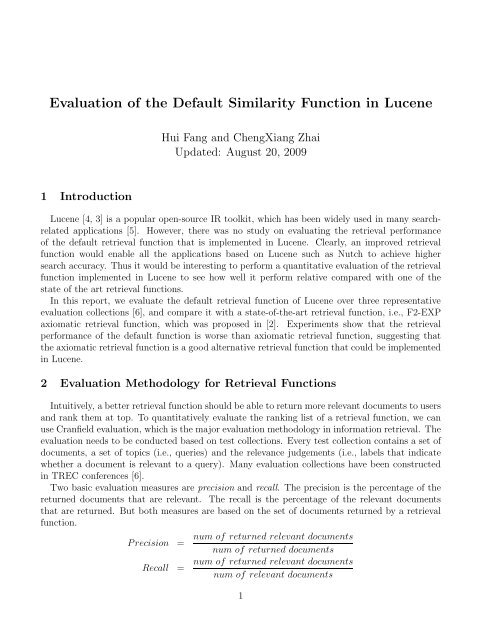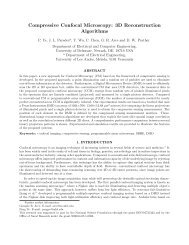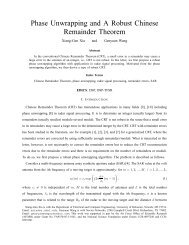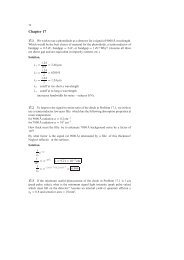Evaluation of the Default Similarity Function in Lucene
Evaluation of the Default Similarity Function in Lucene
Evaluation of the Default Similarity Function in Lucene
Create successful ePaper yourself
Turn your PDF publications into a flip-book with our unique Google optimized e-Paper software.
<strong>Evaluation</strong> <strong>of</strong> <strong>the</strong> <strong>Default</strong> <strong>Similarity</strong> <strong>Function</strong> <strong>in</strong> <strong>Lucene</strong><br />
Hui Fang and ChengXiang Zhai<br />
Updated: August 20, 2009<br />
1 Introduction<br />
<strong>Lucene</strong> [4, 3] is a popular open-source IR toolkit, which has been widely used <strong>in</strong> many searchrelated<br />
applications [5]. However, <strong>the</strong>re was no study on evaluat<strong>in</strong>g <strong>the</strong> retrieval performance<br />
<strong>of</strong> <strong>the</strong> default retrieval function that is implemented <strong>in</strong> <strong>Lucene</strong>. Clearly, an improved retrieval<br />
function would enable all <strong>the</strong> applications based on <strong>Lucene</strong> such as Nutch to achieve higher<br />
search accuracy. Thus it would be <strong>in</strong>terest<strong>in</strong>g to perform a quantitative evaluation <strong>of</strong> <strong>the</strong> retrieval<br />
function implemented <strong>in</strong> <strong>Lucene</strong> to see how well it perform relative compared with one <strong>of</strong> <strong>the</strong><br />
state <strong>of</strong> <strong>the</strong> art retrieval functions.<br />
In this report, we evaluate <strong>the</strong> default retrieval function <strong>of</strong> <strong>Lucene</strong> over three representative<br />
evaluation collections [6], and compare it with a state-<strong>of</strong>-<strong>the</strong>-art retrieval function, i.e., F2-EXP<br />
axiomatic retrieval function, which was proposed <strong>in</strong> [2]. Experiments show that <strong>the</strong> retrieval<br />
performance <strong>of</strong> <strong>the</strong> default function is worse than axiomatic retrieval function, suggest<strong>in</strong>g that<br />
<strong>the</strong> axiomatic retrieval function is a good alternative retrieval function that could be implemented<br />
<strong>in</strong> <strong>Lucene</strong>.<br />
2 <strong>Evaluation</strong> Methodology for Retrieval <strong>Function</strong>s<br />
Intuitively, a better retrieval function should be able to return more relevant documents to users<br />
and rank <strong>the</strong>m at top. To quantitatively evaluate <strong>the</strong> rank<strong>in</strong>g list <strong>of</strong> a retrieval function, we can<br />
use Cranfield evaluation, which is <strong>the</strong> major evaluation methodology <strong>in</strong> <strong>in</strong>formation retrieval. The<br />
evaluation needs to be conducted based on test collections. Every test collection conta<strong>in</strong>s a set <strong>of</strong><br />
documents, a set <strong>of</strong> topics (i.e., queries) and <strong>the</strong> relevance judgements (i.e., labels that <strong>in</strong>dicate<br />
whe<strong>the</strong>r a document is relevant to a query). Many evaluation collections have been constructed<br />
<strong>in</strong> TREC conferences [6].<br />
Two basic evaluation measures are precision and recall. The precision is <strong>the</strong> percentage <strong>of</strong> <strong>the</strong><br />
returned documents that are relevant. The recall is <strong>the</strong> percentage <strong>of</strong> <strong>the</strong> relevant documents<br />
that are returned. But both measures are based on <strong>the</strong> set <strong>of</strong> documents returned by a retrieval<br />
function.<br />
num <strong>of</strong> returned relevant documents<br />
Precision =<br />
num <strong>of</strong> returned documents<br />
num <strong>of</strong> returned relevant documents<br />
Recall =<br />
num <strong>of</strong> relevant documents<br />
1
To evaluate <strong>the</strong> overall rank<strong>in</strong>g <strong>of</strong> a document list, a commonly used measure is Mean Average<br />
Precision, i.e., MAP. For every query, Average Precision (AP) is an average <strong>of</strong> <strong>the</strong> precision<br />
value obta<strong>in</strong>ed after every relevant document is returned. If a relevant document is not returned,<br />
<strong>the</strong> correspond<strong>in</strong>g precision is 0. MAP is an average <strong>of</strong> <strong>the</strong> AP for all <strong>the</strong> queries <strong>in</strong> <strong>the</strong> test<br />
collection. A higher MAP value means that <strong>the</strong> retrieval function can retrieve relevant documents<br />
more quickly and completely.<br />
AP =<br />
MAP =<br />
∑ (precision value obta<strong>in</strong>ed after every relevant document is retrieved)<br />
num <strong>of</strong> relevant documents<br />
∑ (AP <strong>of</strong> every query)<br />
num <strong>of</strong> queries<br />
3 Retrieval <strong>Function</strong>s<br />
3.1 <strong>the</strong> <strong>Default</strong> <strong>Similarity</strong> <strong>Function</strong> <strong>in</strong> <strong>Lucene</strong><br />
The default similary function <strong>in</strong> <strong>Lucene</strong> is derived from vector space model [1], where both<br />
document D and query Q are assumed to be vectors <strong>of</strong> terms. Higher similarity betwteen <strong>the</strong>se<br />
two vectors means that <strong>the</strong> document is more relevantn to <strong>the</strong> query. The scor<strong>in</strong>g function is<br />
shown as follows.<br />
S(Q, D) =<br />
|Q ∩ D|<br />
|Q|<br />
1<br />
× ∑<br />
t∈Q(1 + log<br />
√<br />
N<br />
×<br />
∑<br />
df(t)+1 )2 t∈Q∩D<br />
c(t, D) × (1 + log<br />
√<br />
|D|<br />
N<br />
df(t)+1 )2<br />
where c(t, D) is <strong>the</strong> number <strong>of</strong> occurrences <strong>of</strong> term t <strong>in</strong> document D, df(t) is <strong>the</strong> number <strong>of</strong><br />
documents that conta<strong>in</strong> term t, N is <strong>the</strong> number <strong>of</strong> documents <strong>in</strong> <strong>the</strong> collection, |D| is <strong>the</strong> length<br />
<strong>of</strong> document D, |Q| is <strong>the</strong> length <strong>of</strong> query Q, |Q ∩ D| is <strong>the</strong> number <strong>of</strong> terms that occur <strong>in</strong> both<br />
query Q and document D.<br />
Note that <strong>the</strong> default similarity function can also boost term weight<strong>in</strong>g based on user specified<br />
requirements, e.g., <strong>the</strong> importance <strong>of</strong> <strong>the</strong> fields. S<strong>in</strong>ce <strong>the</strong> data used <strong>in</strong> <strong>the</strong> evaluation only conta<strong>in</strong><br />
one field, we do not <strong>in</strong>clude <strong>the</strong> boost<strong>in</strong>g factors <strong>in</strong> <strong>the</strong> retrieval functions for <strong>the</strong> sake <strong>of</strong> clarity.<br />
3.2 Axiomatic Retrieval <strong>Function</strong><br />
Axiomatic approaches to Information Retrievla have been proposed to develop retrieval functions.<br />
Previous study [2] has shown that <strong>the</strong> derived retrieval function is more robust than o<strong>the</strong>r<br />
state-<strong>of</strong>-<strong>the</strong>-art retrieval functions with comparable optimal performance. The follow<strong>in</strong>g function<br />
(F2-EXP) is one <strong>of</strong> <strong>the</strong> best perform<strong>in</strong>g functions that have been derived us<strong>in</strong>g axiomatic<br />
approach.<br />
S(Q, D) = ∑<br />
t∈Q∩D<br />
c(t, Q) · ( N<br />
df(t) )k ·<br />
c(t, D)<br />
c(t, D) + s + s·|D|<br />
avdl<br />
where S(Q, D) represents <strong>the</strong> relevance score <strong>of</strong> document D for query Q, c(t, Q) is <strong>the</strong> number <strong>of</strong><br />
occurrences <strong>of</strong> term t <strong>in</strong> query Q, df(t) is <strong>the</strong> number <strong>of</strong> documents that conta<strong>in</strong> term t, c(t, D) is<br />
2<br />
,<br />
,
Table 1. Performance Comparison<br />
Collection <strong>Function</strong> MAP P@5 P@10 P@20 P@100 NumRR<br />
web <strong>Lucene</strong> <strong>Default</strong> 0.18 0.34 0.32 0.26 0.13 1474<br />
Axiomatic 0.26 0.44 0.41 0.33 0.18 1644<br />
trec7 <strong>Lucene</strong> <strong>Default</strong> 0.15 0.4 0.35 0.30 0.15 2018<br />
Axiomatic 0.18 0.41 0.38 0.33 0.17 2137<br />
trec8 <strong>Lucene</strong> <strong>Default</strong> 0.17 0.4 0.38 0.31 0.18 2155<br />
Axiomatic 0.19 0.42 0.38 0.30 0.17 2168<br />
<strong>the</strong> number <strong>of</strong> occurrences <strong>of</strong> term t <strong>in</strong> document D, |D| is length <strong>of</strong> document D, and avdl is <strong>the</strong><br />
average document length <strong>in</strong> <strong>the</strong> collection. s and k are two parameters. Sett<strong>in</strong>g <strong>the</strong>m to default<br />
values, i.e., k = 0.35 and s = 0.5, can <strong>of</strong>ten yield to near-optimal performance for different data<br />
colletions.<br />
4 Experiments<br />
In this section, we experimentally compare <strong>the</strong> default function <strong>in</strong> <strong>Lucene</strong> with <strong>the</strong> axiomatic<br />
retrieval function. Experiment results show that <strong>the</strong> axiomatic retrieval function achieves much<br />
higher search accuracy than <strong>the</strong> default function <strong>in</strong> <strong>Lucene</strong>.<br />
4.1 Experiment Setup<br />
We conduct <strong>the</strong> experiments over three standard TREC collections: <strong>the</strong> Web data used <strong>in</strong><br />
TREC 8 (web) and <strong>the</strong> ad hoc data used <strong>in</strong> TREC 7 (trec7) and TREC 8 (trec8). Both<br />
collections are relatively large and represent two different genres. web collection <strong>in</strong>cludes 227,725<br />
documents and 50 queries, and ei<strong>the</strong>r trec7 or trec8 collection conta<strong>in</strong>s 528,155 documents and<br />
50 queries. We use StandardAnalyzer to pre-process both query sets and document collections.<br />
In particular, we represent all queries as BOOLEAN queries provided by <strong>Lucene</strong>.<br />
4.2 Experiment Results<br />
Table 1 shows <strong>the</strong> evaluation results for both <strong>the</strong> default function <strong>in</strong> <strong>Lucene</strong> and <strong>the</strong> axiomatic<br />
retrieval function. P@N means <strong>the</strong> precision at top N ranked documents. NumRR is <strong>the</strong> number <strong>of</strong><br />
returned relevant documents. MAP is <strong>the</strong> mean average precision as we described <strong>in</strong> <strong>the</strong> previous<br />
section. For all <strong>the</strong> measures, higher value means <strong>the</strong> better results.<br />
On web collection, <strong>the</strong> axiomatic function has higher MAP value compared with <strong>Lucene</strong>’s<br />
default function, i.e., 0.262 vs. 0.188. In particular, we can see <strong>the</strong> axiomatic function is able to<br />
rank relevant documents higher based on P@N value. For example, it returns approximately 0.5<br />
more relevant document <strong>in</strong> top 5 ranked documents, 1 more relevant documents <strong>in</strong> top 10, 1.4<br />
more relevant documents <strong>in</strong> top 20, and 5 more relevant documents <strong>in</strong> top 100. Fur<strong>the</strong>rmore, for<br />
all <strong>the</strong> queries <strong>in</strong> a collection, <strong>the</strong> axiomatic function can return more relevant documents <strong>in</strong> <strong>the</strong><br />
top ranked 1000 documents than <strong>the</strong> <strong>Lucene</strong>’s default function, i.e., 1644 vs. 1474. We can make<br />
<strong>the</strong> similar observation on <strong>the</strong> o<strong>the</strong>r two collections.<br />
3
5 Conclusions<br />
In this report, we empirically evaluate <strong>the</strong> retrieval performance <strong>of</strong> <strong>the</strong> default retrieval function<br />
<strong>in</strong> <strong>Lucene</strong>, and compared it with a state-<strong>of</strong>-art retrieval function, i.e., axiomatic retrieval function.<br />
Experiments show that <strong>the</strong> performance <strong>of</strong> <strong>the</strong> default function is much worse than <strong>the</strong> state<strong>of</strong>-<strong>the</strong>-art<br />
retrieval function. Therefore, it would be desirable to implement a state-<strong>of</strong>-<strong>the</strong>-art<br />
retrieval function such as <strong>the</strong> axiomatic retrieval function <strong>in</strong> <strong>Lucene</strong>. We have implemented<br />
<strong>the</strong> axiomatic retrieval functions (AXTermQuery.java and AXTermScorer.java) based on <strong>Lucene</strong><br />
and created a web page that provides <strong>the</strong> download <strong>the</strong> implementation and example codes <strong>of</strong><br />
us<strong>in</strong>g <strong>the</strong> implementation (BuildIndex.java and RetAXEval.java). The codes can be downloaded<br />
at http://www.ece.udel.edu/˜hfang/<strong>Lucene</strong>AX.html. We hope that <strong>the</strong> implementation could be<br />
comb<strong>in</strong>ed with <strong>the</strong> future releases <strong>of</strong> <strong>Lucene</strong>.<br />
References<br />
[1] <strong>Default</strong> <strong>Similarity</strong> <strong>Function</strong> <strong>of</strong> <strong>Lucene</strong>. http://lucene.zones.apache.org:8080/hudson/job/lucenenightly/javadoc/org/apache/lucene/search/similarity.html.<br />
[2] H. Fang and C. Zhai. An Exploration <strong>of</strong> Axiomatic Approaches to Information Retrieval. 2005.<br />
[3] E. Hatcher and O. Gospodnetic. <strong>Lucene</strong> <strong>in</strong> Action. Mann<strong>in</strong>g Publications Co., 2004.<br />
[4] <strong>Lucene</strong>. http://lucene.apache.org/java/docs/.<br />
[5] Nutch. http://lucene.apache.org/nutch/.<br />
[6] E. Voorhees and D. Harman, editors. Proceed<strong>in</strong>gs <strong>of</strong> Text REtrieval Conference (TREC1-9).<br />
NIST Special Publications, 2001. http://trec.nist.gov/pubs.html.<br />
4











